How dirty is your child’s stuffed animal? Understanding the hidden health risks |

Children’s stuffed animals are cherished companions, yet they may carry far more than comfort. A peer-reviewed study published in the International Journal of Environmental Research and Public Health tested toys from households and daycares, revealing that every stuffed animal harboured bacterial growth, including E. coli and Staphylococcus aureus. These bacteria can increase the risk of infections, particularly for young children with developing immune systems. The study also found that simple machine washing could significantly reduce contamination. Understanding how bacteria accumulate on soft toys and how to clean them properly is essential for maintaining your child’s health while keeping their favourite toy safe, soft, and hygienic.
Bacteria on stuffed animals: What parents need to know
Soft toys, especially those frequently handled or carried everywhere, can become a reservoir for bacteria. The study highlighted that toys in constant contact with children’s hands, mouths, and even pets showed higher bacterial levels. These bacteria can multiply rapidly in warm and moist environments, making regular cleaning essential. Without proper hygiene, children may be exposed to pathogens that could trigger skin irritations, respiratory issues, or gastrointestinal infections.
Why cleaning your child’s stuffed animal matters
Regular cleaning of stuffed animals is vital for multiple reasons:
- Health protection: Removes harmful bacteria and allergens that can cause illness.
- Toy longevity: Helps maintain softness and durability over time.
- Home hygiene: Reduces overall bacterial load in children’s environments.
- Creating a routine for cleaning and sanitising toys ensures children can safely enjoy their favourite companions.
How to clean stuffed animals safely
Cleaning methods depend on the toy’s materials. Here are effective options:
- Machine washing: Place the toy in a pillowcase or laundry bag and wash on a gentle cycle with cold water and mild detergent.
- Hand washing: For delicate toys, use warm soapy water, gently scrub, rinse thoroughly, and air dry.
- Spot cleaning: Apply detergent to specific stains, gently scrub, rinse, and dry.
- Always check the manufacturer’s instructions before cleaning to avoid damaging the toy.
When to replace stuffed animals for safety
Even with regular cleaning, some toys may become unsafe or unhygienic. Replace stuffed animals if you notice:
- Loss of shape: The toy is misshapen or flattened.
- Persistent odour: Unpleasant smells remain after cleaning.
- Visible damage: Tears, missing parts, or worn fabric.
- Replacing worn-out toys ensures continued safety and comfort for your child.
While stuffed animals provide emotional support and comfort, they can harbour hidden bacteria that pose health risks. Using proper cleaning techniques and regularly inspecting toys can significantly reduce contamination. Incorporating routine washing, spot cleaning, and timely replacement helps protect children from infections while preserving the comfort of their favourite companions. By following these steps, parents can maintain both hygiene and the joy of their child’s cherished soft toys.Disclaimer: This article is for general informational purposes only and is not a substitute for professional medical advice, diagnosis, or treatment. Always seek the guidance of a qualified healthcare provider regarding any medical condition or lifestyle change.Also read| Headache or brain tumour? Neurosurgeon explains the warning signs you shouldn’t ignore






